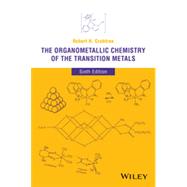
Acknowledgment
List of Abbreviations
1 Introduction
1.1 Why Study Organometallic Chemistry? 1.1
1.2 Coordination Chemistry 1.2
1.3 Werner Complexes 1.3
1.4 The Trans Effect 1.5
1.5 Soft versus Hard Ligands 1.5
1.6 The Crystal Field 1.6
1.7 The Ligand Field 1.10
1.8 the sdn Model and Hypervalency 1.11
1.9 Back Bonding 1.12
1.10 Electroneutrality 1.14
1.11 Types of Ligand 1.15
2 Making Sense of Organometallic Complexes
2.1 The 18-Electron Rule 2.1
2.2 Limitations of the 18-Electron Rule 2.6
2.3 Electron Counting in Reactions 2.7
2.4 Oxidation State 2.8
2.5 Coordination Number and Geometry 1.12
2.6 Effects of Complexation 2.13
2.7 Differences between Metals 2.15
3 Alkyls and Hydrides
3.1 Alkyls and Aryls 3.1
3.2 Other s-Bonded Ligands 3.9
3.3 Metal Hydrides 3.10
3.4 S???????? Complexes 3.12
3.5 Bond Strengths 3.13
4 Carbonyls Phosphines and Substitution
4.1 Metal Carbonyls 4.1
4.2 Phosphines 4.2
4.3 N-Heterocyclic Carbenes (NHCs) 4.8
4.4 Dissociative Substitution 4.9
4.5 Associative Substitution 4. 11
4.6 Redox Effects and Interchange Substitution 4.13
4.7 Photochemical Substitution 4.14
4.8 Counterions and Solvents in Substitution 4.15
5 Complexes of p-Bound Ligands
5.1 Alkene and Alkyne Complexes 5.1
5.2 Allyls 5.4
5.3 Diene Complexes 5.5
5.4 Cyclopentadienyl Complexes 5.7
5.5 Arenes and Other Alicyclic Ligands 5.9
5.6 Isolobal Replacement and Metalacycles 5.11
5.7 Stability of Polyene and Polyenyl Complexes 5.12
6 Oxidative Addition and Reductive Elimination
6.1 Introduction 6.1
6.2 Concerted Additions 6.2
6.3 SN2 Pathways 6.4
6.4 Radical Mechanisms 6.5
6.5 Ionic Mechanisms 6.5
6.6 Reductive Elimination 6.7
6.7 s-Bond Metathesis 6.10
6.8 Oxidative Coupling and Reductive Fragmentation 6.10
7 Insertion and Elimination
7.1 Introduction 7.1
7.2 CO Insertion 7.2
7.3 Alkene Insertion 7.4
7.4 Other Insertions 7.7
7.5 a, b, g, and d Elimination 7.7
8 Nucleophilic and Electrophilic Addition and Abstraction
8.1 Introduction 8.1
8.2 Nucleophilic Addition to CO 8.2
8.3 Nucleophilic Addition to Polyene and Polyenyls 8.3
8.4 Nucleophilic Abstraction in Hydrides Alkyls and Acyls 8.4
8.5 Electrophilic Addition and Abstraction 8.7
8.6 Single-Electron Transfer and Radical Reactions 8.8
9 Homogeneous Catalysis
9.1 Catalytic Cycles 9.1
9.2 Alkene Isomerization 9.5
9.3 Hydrogenation 9.5
9.4 Alkene Hydroformylation 9.10
9.5 Alkene Hydrocyanation 9.11
9.6 Alkene Hydrosilylation and Hydroboration 9.11
9.7 Coupling Reactions 9.12
9.8 Organometallic Oxidation Catalysis 9.13
9.9 Surface and Supported Organometallic Catalysis 9.14
10 Physical Methods
10.1 Isolation 10.1
10.2 1H NMR Spectroscopy 10.1
10.3 13C NMR Spectroscopy 10.3
10.4 31P NMR Spectroscopy 10.3
10.5 Dynamic NMR 10.4
10.6 Spin Saturation Transfer 10.6
10.7 T1 and the Nuclear Overhauser Effect 10.6
10.8 IR Spectroscopy 10.8
10.9 Crystallography 10.9
10.10 Electrochemistry and EPR 10.11
10.11 Computation 10.12
10.12 Other Methods 10.13
11 M—L Multiple Bonds
11.1 Carbenes 11.1
11.2 Carbynes 11.7
11.3 Bridging Carbenes and Carbynes 11.8
11.4 N-Heterocyclic Carbenes 11.8
11.5 Multiple Bonds to Heteroatoms 11.10
12 Applications
12.1 Alkene Metathesis 12.1
12.2 Dimerization Oligomerization and Polymerization of Alkenes 12.4
12.3 Activation of CO and CO2 12.7
12.4 C–H Activation 12.9
12.5 Green Chemistry 12.12
12.6 Energy Chemistry 12.13
13 Clusters Nanoparticles Materials and Surfaces
13.1 Cluster Structures 13.1
13.2 The Isolobal Analogy 13.6
13.3 Nanoparticles 13.8
13.4 Organometallic Materials 13.10
14 Organic Applications
14.1 Carbon–Carbon Coupling 14.2
14.2 Metathesis 14.4
14.3 Cyclopropanation and C–H Insertion 14.5
14.4 Hydrogenation 14.5
14.5 Carbonylation 14.6
14.6 Oxidation 14.6
14.7 C–H Activation 14.8
14.8 Click Chemistry 14.10
15 Paramagnetic and High-Oxidation-State Complexes
15.1 Magnetism and Spin States 15.2
15.2 Polyalkyls and Polyhydrides 15.5
15.3 Cyclopentadienyl Complexes 15.7
15.4 f-Block Complexes 15.8
16 Bioorganometallic Chemistry
16.1 Introduction 16.1
16.2 Coenzyme B12 16.5
16.3 Nitrogen Fixation 16.8
16.4 Nickel Enzymes 16.12
16.5 Biomedical and Biocatalytic Applications 16.15
Useful Texts on Allied Topics 000
Major Reaction Types 000
Solutions to Problems 000
Index
The New copy of this book will include any supplemental materials advertised. Please check the title of the book to determine if it should include any access cards, study guides, lab manuals, CDs, etc.
The Used, Rental and eBook copies of this book are not guaranteed to include any supplemental materials. Typically, only the book itself is included. This is true even if the title states it includes any access cards, study guides, lab manuals, CDs, etc.